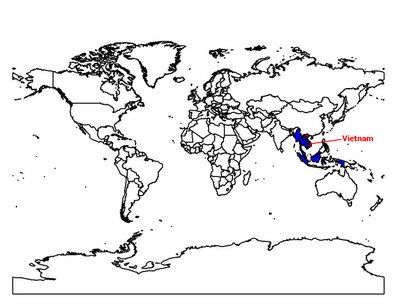
Vietnamese cuisine can be divided into three regional categories: 1) Northern Vietnamese – where the food preparation is simpler in comparison to that of the Central and South, featuring stir-fries and often employing the use of soy sauce (Northern cuisine is generally more Chinese influenced). 2) Southern Vietnamese – where there is an extensive use of different vegetables, fish, and other seafood; it is typically also the most French influenced. 3) Central Vietnamese – the most unique of the three and probably the most distinct in taste being much spicier than its Northern and Southern counterparts, as well as being much more colorful. Central cooking is also obviously influenced by the royal setting (therefore by the little-known royal Vietnamese cooking), being not only very spicy and colorful but focusing on a multitude of small side dishes set on the table at once. The more dishes on a family table, the wealthier that particular family was.
Vietnamese cuisine is known for its common use of fish sauce, soy sauce and hoisin sauce. Vietnamese recipes use many vegetables, herbs and spices, including lemon grass, lime, and kaffir lime leaves. Throughout all regions the emphasis is always on serving fresh vegetables and/or fresh herbs as side dishes along with dipping sauce. The Vietnamese also have a number of Buddhist vegetarian dishes.
The most common meats used in Vietnamese cuisine are pork, beef, prawns, various kinds of tropical fish, and chicken. Duck is used less widely. The consumption of meats such as snake, soft-shell turtle, goat, and dog meat are a phenomenon enjoyed almost exclusively as "cocktail delicacies" with alcohol, and are not considered typical everyday fare. However, dog meat consumption is more widespread in the North, where it is considered a borderline mainstream meat, although not eaten nearly as often as pork or fish.
Spring rolls almost constitute an entire category of Vietnamese foods, as there are numerous different kinds of spring rolls with different ingredients in them. They include:
Bi cuon – Rice paper rolls with the bi mixture of thinly shredded pork and thinly shredded pork skin, among other ingredients, along with salad
Bo bia – Fried daikon and carrots, Chinese sausage, shredded scrambled eggs, all wrapped with vermicelli noodle in a rice paper roll. Dipped into a spicy peanut sauce (with freshly roasted and grounded peanuts).
Ca cuon – A roll with fish and spring onions.
Bo la lot – Not strictly a spring roll, but rather spiced beef rolled in betel leaf and grilled.
Other popular Vietnamese dishes:
Bo 7 Mon – Vietnamese seven courses of Beef. Typically served at weddings. A less popular version is the Ca 7 Mon - or, seven courses of fish. These multi-course meals are on the more higher-eating end of Vietnamese cuisine.
Bun Thit Nuong – One of the more popular (and simple) Vietnamese dishes, basically a combination Vermicelli plate, a kind of vermicelli counterpart to Com tam. Grilled pork (often shredded) and vermicelli noodles over a bed of greens (salad and sliced cucumber), herbs and bean sprouts. Also often include a few chopped up egg rolls, spring onions, and shrimp. Served with roasted peanuts on top and a small bowl of Nuoc cham (peanut sauce).
Com Tam – Grilled pork (either ribs or shredded) plus a Vietnamese dish called bi (thinly shredded pork mixed with cooked and thinly shread pork skin) over broken rice (what the words "com tam" actually mean in Vietnamese). The rice and meat are served with various greens and pickled vegetables, along with a prawn paste cake, chung hap (Vietnamese adaptation of Chinese Egg Foo Young), and grilled prawns. Typically restaurants will serve this popular combination rice plate with a small bowl of Nuoc cham (peanut sauce), as well as a small bowl of soup broth with spring onions (to cleanse the throat). A fried egg sunny-side-up is sometimes substituted for the chung hap.
Mi Quang – A very popular yet extremely complicated egg noodle soup dish. Originating from Quang Nam, Mi Quang varies in its preparation and features very sharply contrasting flavors and textures in (if prepared properly) a shallowly filled bowl of broth, noodles, herbs, vegetables, and chips.
For more go to:
http://en.wikipedia.org/wiki/Cuisine_of_Vietnam
No comments:
Post a Comment